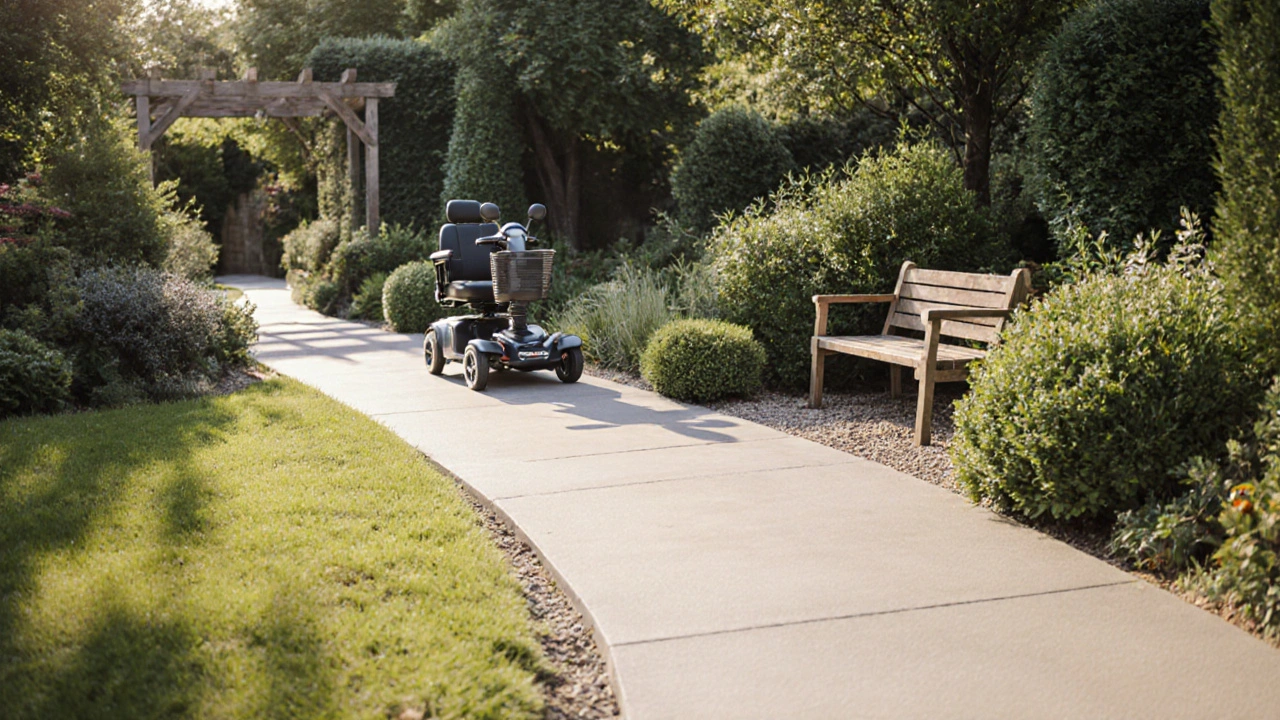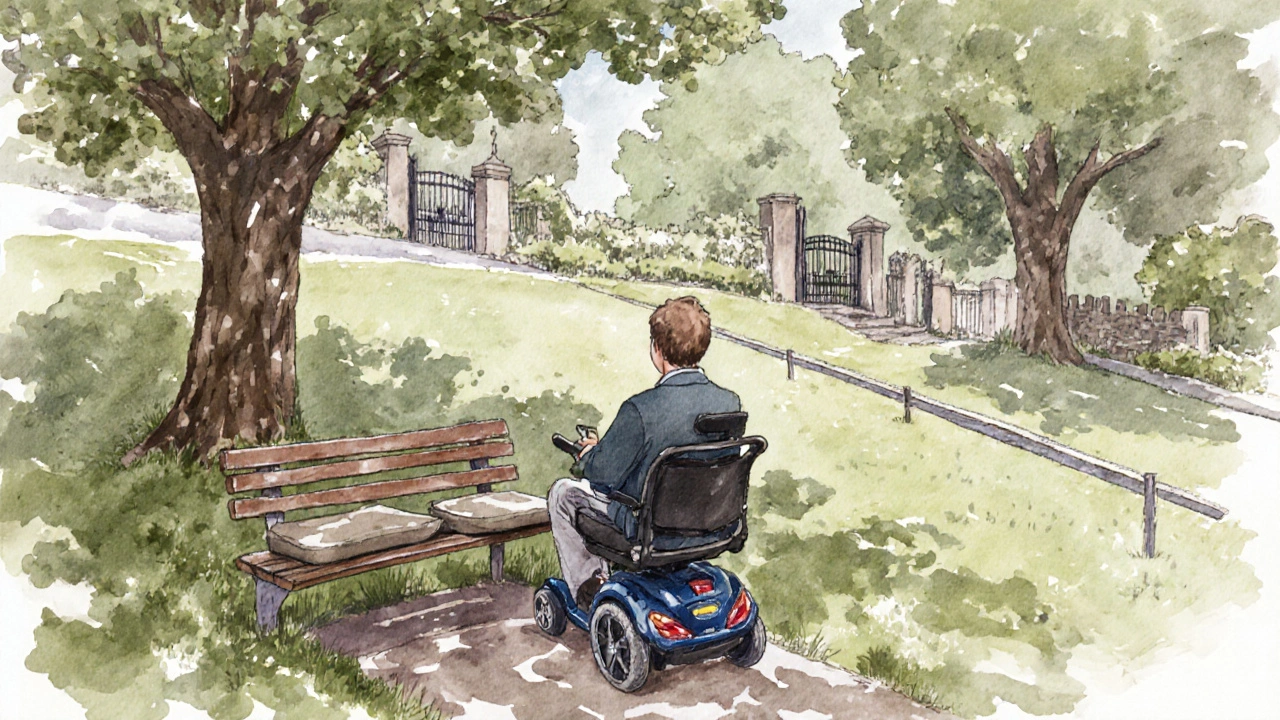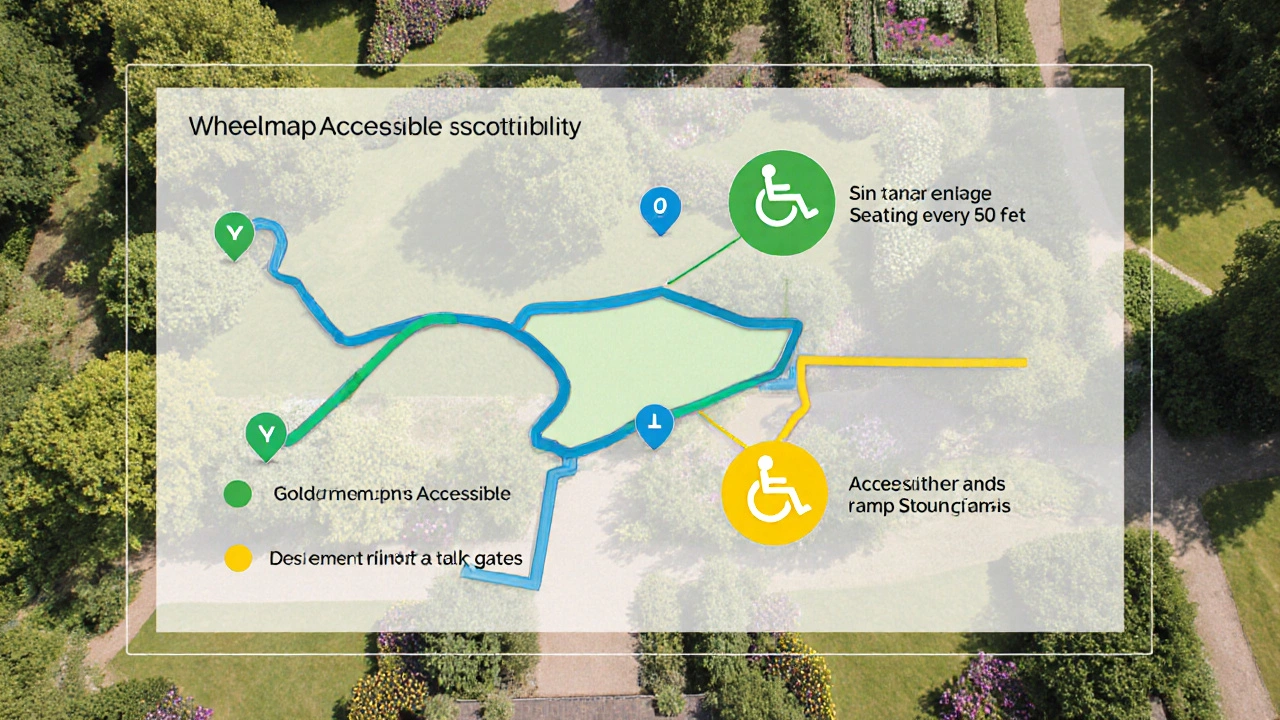
Many people think gardens are just for walking, but what if you can’t walk far? Or if standing for long periods hurts? Or if you rely on a mobility scooter to get around? Gardens shouldn’t be a challenge-they should be a comfort. Whether it’s a backyard, a community park, or a public botanical garden, making outdoor spaces easy to use matters. And it’s easier than you think.
Designing Gardens for Mobility Scooters
Mobility scooters aren’t just for roads. They’re perfect for smooth, wide paths in gardens. But not every garden lets them in. The problem isn’t the scooter-it’s the path.
Most mobility scooters need at least 36 inches (91 cm) of clear space to turn comfortably. Narrow gravel paths, tight corners, and overgrown shrubs block access. If you’re planning a garden or managing one, start with the basics: level ground, firm surfaces, and no sudden drops.
Use compacted gravel, paved concrete, or smooth asphalt. Avoid loose soil, sand, or wood chips. These sink under weight and make steering hard. In Dundee, where rain is common, drainage matters too. Slope paths slightly-about 1 in 20-to let water run off without pooling.
Wider gates help. A standard garden gate is 30 inches wide. That’s too narrow. Upgrade to 36 inches or more. Hinges should open outward so they don’t swing into the path. Automatic openers aren’t necessary, but a lever handle instead of a knob makes it easier for people with limited hand strength.
Seating That Works for Everyone
People don’t sit because they’re tired. They sit because standing hurts. Or because they have arthritis, heart issues, or balance problems. Good seating isn’t just about benches-it’s about safety and comfort.
Look for benches with back support and armrests. No slats that dig into your legs. No low seats that make standing up hard. The ideal seat height is 18 to 20 inches off the ground. That’s about the same as a standard chair. Add a slight forward tilt to help people push up with their arms.
Place seats every 50 to 75 feet along main paths. That’s about the distance most people can walk before needing to rest. Include shade. A bench in full sun on a summer day can be unbearable. Use pergolas, trees, or umbrellas. In Scotland, even in summer, a little shelter from wind helps.
Don’t forget materials. Wood is nice, but it gets slippery when wet. Treated timber or textured composite materials are better. Avoid metal benches in cold weather-they get icy and stick to skin. Add cushions only if they’re weather-resistant and easy to clean.
Map Apps That Actually Help
Most garden maps are useless for people with mobility issues. They show flowers and fountains, but not ramps, restrooms, or level paths. You need maps that tell you where it’s safe to go.
Some public gardens in Scotland now use digital maps with accessibility filters. Apps like Accessible Scotland and Wheelmap let users search for gardens and see which ones have:
- Level entrances
- Wide, smooth paths
- Accessible toilets
- Seating every 50 feet
- No steps or steep slopes
These apps use real user reports, not just official descriptions. Someone with a scooter might flag a path that looks flat but has hidden cracks. Another person might note that a restroom door is too narrow for a wheelchair. That kind of detail saves hours of frustration.
Even if your local garden doesn’t have a special app, Google Maps often has accessibility tags now. Search for the garden, then tap the info card. Look for phrases like “wheelchair accessible” or “step-free access.” Click on photos-sometimes you’ll see ramps or paved paths in the images.
For private gardens, take a photo of the path with your phone and use the measurement tool. If it’s less than 36 inches wide, it’s not scooter-friendly. If there are more than three steps in a row, it needs a ramp.

Easy Upgrades That Make a Big Difference
You don’t need a full redesign. Small changes add up.
- Replace a few uneven paving stones with flat ones.
- Add handrails along slopes-even if they’re short.
- Use contrasting colors on steps so they’re easier to see.
- Keep paths clear of hoses, toys, or garden tools.
- Install motion-sensor lights near seating areas for evening use.
One gardener in Perth replaced a winding gravel path with a straight concrete one. She added four benches and linked her garden to Wheelmap. Within months, she had visitors she’d never seen before-older neighbors, people with chronic pain, families with young kids in strollers. Everyone said the same thing: “I finally felt welcome here.”
Why This Matters Beyond Convenience
Accessibility isn’t about charity. It’s about dignity. It’s about being able to smell roses without needing help. It’s about sitting under a tree without worrying if you’ll be able to stand back up.
When gardens are designed for everyone, they become more than pretty spaces. They become community hubs. People who used to stay home start visiting. Friends meet. Conversations happen. Loneliness drops.
Scotland has aging populations. By 2030, nearly one in four people will be over 65. Many will need mobility aids. Gardens that don’t adapt will become empty. Those that do will thrive.
It’s not expensive. A 50-foot stretch of smooth path costs less than £200. A bench with back support runs £150. A free app costs nothing. The return? More visitors. Happier people. Stronger communities.

What to Avoid
Don’t assume what someone needs. Don’t install a ramp that’s too steep. Don’t put benches where no one can reach them. Don’t rely on signs that say “accessible” without proof.
Test your garden yourself. Borrow a mobility scooter or wheelchair. Drive or push it along the paths. See how it feels. Ask someone who uses one. Listen to their feedback. Don’t fix what you think is broken-fix what they say is broken.
Also, avoid fake accessibility. A ramp that’s too narrow. A toilet that’s labeled “accessible” but has a door that won’t open. These are worse than no accessibility at all. They send a message: “We tried, but not really.”
Start Small. Think Big.
You don’t need to rebuild your whole garden. Pick one path. Add one bench. Link it to a map app. Talk to your neighbors. See who uses the space. Ask them what would help.
Accessibility isn’t a checklist. It’s a mindset. It’s about seeing the garden through someone else’s eyes. And when you do that, you don’t just make it easier to move around-you make it more beautiful to be in.
Can mobility scooters go on grass or gravel paths?
Most mobility scooters struggle on loose surfaces like grass, sand, or gravel. These materials shift under weight, making steering difficult and increasing the risk of tipping. Firm, compacted surfaces like smooth asphalt, paved concrete, or tightly packed gravel are best. If you must use gravel, choose crushed stone that’s finely graded and well-compacted.
How wide should garden paths be for accessibility?
Paths should be at least 36 inches (91 cm) wide to allow a mobility scooter or wheelchair to turn comfortably. For two-way traffic or tight spaces, aim for 48 inches. Avoid narrow gates or archways-these often block access even if the path itself is wide enough.
What’s the best height for garden seating?
Ideal garden seating should be between 18 and 20 inches high-similar to a standard chair. This height makes it easier to sit down and stand up without straining. Seats should also have armrests and back support. Avoid low, flat benches without support-they’re hard to get up from, especially for people with joint pain.
Are there free apps that show accessible gardens in Scotland?
Yes. Apps like Wheelmap and Accessible Scotland let users search for gardens and parks with verified accessibility features. They show real user reports on path surfaces, ramp access, toilet availability, and seating. Google Maps also increasingly includes accessibility tags-look for “wheelchair accessible” in the venue details. These tools are free and updated by the community.
Do I need to spend a lot of money to make my garden accessible?
Not at all. Simple upgrades like replacing a few uneven stones, adding a single bench with armrests, or installing a handrail on a short slope can cost under £200. Many local councils offer small grants for accessibility improvements in private gardens, especially for older residents. The biggest cost isn’t materials-it’s time and awareness. Start small, ask for feedback, and build from there.
Comments (10)
-
Bob Buthune November 16, 2025
I remember when I first tried to take my scooter to the botanical garden downtown. Thought it’d be fine-looked nice on the website. Turned out the path was all loose cedar chips. My scooter just sank in like I was driving through oatmeal. Took me 20 minutes to get back out. I cried. Not because I was mad, but because I felt like I’d been invited to a party… and then told I couldn’t wear my shoes. 🥲 Now I check Wheelmap before I leave the house. It’s not perfect, but it’s the closest thing to a lifeline I’ve got.
-
Jane San Miguel November 18, 2025
While the sentiment is commendable, the practical recommendations lack architectural rigor. The assertion that 36 inches is sufficient for mobility scooters is empirically flawed; ADA guidelines mandate 42 inches for unobstructed turning radii in public spaces. Furthermore, the omission of slope gradients beyond 1:20 is a critical oversight-many jurisdictions require 1:12 for permanent ramps. This piece reads less like an accessibility guide and more like a well-intentioned but dangerously incomplete blog post.
-
Kasey Drymalla November 18, 2025They dont want you to have gardens. Thats why they make the paths narrow. Its all part of the agenda. The same people who control the hospitals control the parks. You think they want old people to be happy? Nah. They want you dependent. Thats why they dont fix the benches. Its not about money. Its about control.
-
Dave Sumner Smith November 20, 2025You people are so naive. You think a bench or a paved path fixes anything? You think the government cares? They just want you to think you have options. Theyll let you roll down a smooth path so youll stop screaming about how they stole your social security. Meanwhile the real problem is the pharmaceutical companies and the insurance bots that decide if you get a new scooter or not. This article is a distraction. A shiny rock thrown into the sewer so you forget the whole system is rigged.
-
Cait Sporleder November 21, 2025
It is profoundly moving to observe how the intersection of horticultural design and universal accessibility can yield not merely functional outcomes, but profound sociocultural transformations. The notion that gardens may serve as equitable sanctuaries-rather than exclusive aesthetic displays-is a paradigm shift of considerable magnitude. I am particularly struck by the emphasis on community-sourced data via applications such as Wheelmap, which exemplifies the democratization of spatial knowledge. Furthermore, the integration of tactile, chromatic, and ergonomic considerations into the hardscape design demonstrates an emergent ethos of compassionate urbanism. One cannot help but reflect upon the philosophical underpinnings of Heidegger’s ‘dwelling’-how the act of making space hospitable becomes an ethical imperative, not a charitable gesture.
-
Paul Timms November 22, 2025This is exactly what my mom needed. She’s been stuck inside for three years. We added one bench near the front and repaved a 20-foot stretch. She goes out every morning now. Just sits. Smells the lavender. Doesn’t say much. But she smiles. That’s all that matters.
-
Jeroen Post November 23, 2025You think this is about gardens? Nah. This is about control. They want you to think accessibility is about ramps and benches. But what they really want is for you to accept your place. The moment you start asking for more than a paved path, they call it expensive. The moment you ask for a ramp with handrails and lighting and shade and seating every 50 feet? They say no. Because if you can move freely then you might start asking why your rent went up or why your meds are $800. This isn’t about gardens. This is about keeping you quiet.
-
Nathaniel Petrovick November 24, 2025My uncle uses a scooter and we just put down some rubberized pavers in his backyard. Cost like $150. He says it’s the first time in 10 years he’s felt like he can just… be outside. No one helped us. We just did it. You don’t need a committee. You just need to care enough to try.
-
Honey Jonson November 25, 2025i just moved my moms bench to the shade and added a little cushion and she cries every time she sits there now. not sad tears. happy ones. she says its like the garden hugs her back. also i spelled cushion wrong but you know what i mean. <3
-
Sally McElroy November 27, 2025It’s deeply troubling that this article frames accessibility as a matter of convenience rather than a moral obligation. The fact that we must rely on apps like Wheelmap to even verify whether a space is hospitable to human beings with mobility impairments speaks to a systemic failure of empathy. We are not asking for favors-we are demanding basic dignity. And yet, we are met with half-measures, performative upgrades, and the quiet assumption that our presence is an afterthought. This isn’t progress. It’s minimal compliance disguised as kindness.
